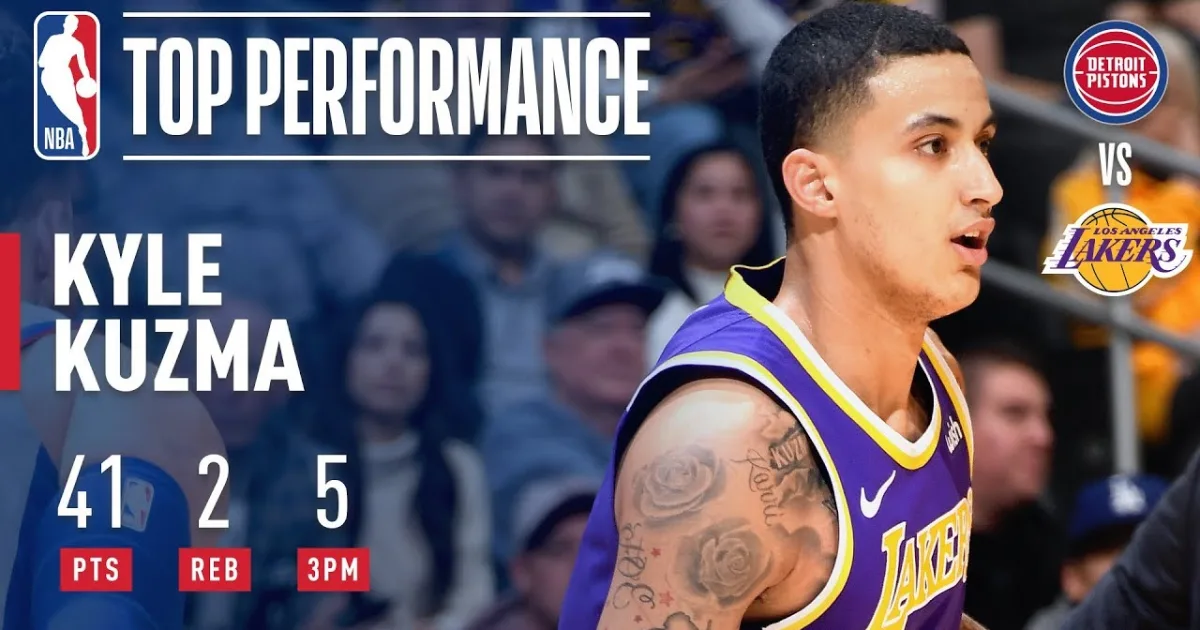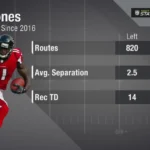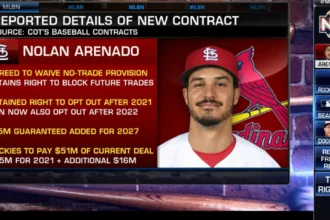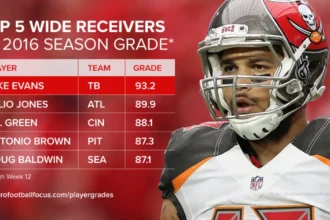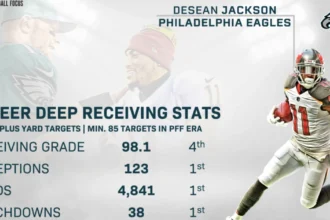Hey there, basketball fans! If you’re tuning in to learn about one of the NBA’s most stylish and skilled forwards, you’ve landed in the right spot. Kyle Kuzma isn’t just a guy who can light up the scoreboard—he’s a story of grit, growth, and that never-say-die attitude that makes hoops so addictive. Born in the tough streets of Flint, Michigan, Kuzma has carved out a solid career that’s equal parts highlight-reel dunks and quiet determination. Today, we’re breaking down his career stats in a way that’s straightforward, fun, and easy to follow, no matter if you’re a die-hard Lakers fan or just dipping your toes into NBA waters. We’ll chat about his early days, season-by-season highlights, and of course, a full table of those all-important numbers. Grab a snack, settle in, and let’s talk Kuz!
From Flint to the Spotlight: Kyle Kuzma’s Humble Beginnings
Picture this: It’s the mid-90s in Flint, Michigan—a city famous for its car factories but infamous for its struggles with poverty and crime. That’s where Kyle Alexander Kuzma entered the world on July 24, 1995. His mom, Karri Kuzma, was a high school track star who threw the shot put like a boss, but life wasn’t easy. She worked multiple jobs to keep the family afloat, raising Kyle and his two half-siblings, Andre and Briana, with help from a father figure named Larry Smith. Basketball became Kyle’s escape, a way to dream bigger than the blocks around him.
High school started at Bentley High in Burton, Michigan, where Kuzma was already turning heads as a junior, posting double-doubles like it was no big deal. But he knew he needed more polish to chase his NBA dreams, so he transferred to Rise Academy, a prep powerhouse in Philadelphia. There, he honed his skills against top talent, bulking up his frame to 6-foot-9 and 221 pounds while developing that smooth lefty shooting stroke. Scouts started noticing this kid who could score from anywhere—inside, outside, you name it.
College took him to the University of Utah, where he joined the Utes as a skinny freshman in 2013. It wasn’t an instant splash; he averaged just 3 points as a newbie. But by his sophomore year, Kuzma flipped the script, starting every game and bumping his numbers to 10.8 points and 5.7 rebounds. His junior season? Pure magic. He exploded for 16.4 points, 9.3 boards, and even snagged first-team All-Pac-12 honors. Utah won 47 games over his last two years, but Kuzma had his eyes on the pros. He declared for the 2017 NBA Draft, projected as a late first-rounder or even undrafted. Boy, were those scouts in for a surprise.
Draft night in Brooklyn was wild. The Nets picked him 27th overall, but in a blockbuster trade, he was shipped to the Los Angeles Lakers along with Brook Lopez for D’Angelo Russell and Timofey Mozgov. Suddenly, Kuzma was in purple and gold, rubbing shoulders with future stars like Lonzo Ball and Brandon Ingram. Little did he know, this move would kickstart a career full of ups, downs, and one unforgettable championship. (That’s from his early bio highlights on sites like Basketball-Reference.com.)
Rookie Sensation: Bursting onto the Lakers Scene
Fast-forward to the 2017-18 season, and Kuzma wasted no time proving he belonged. As a rookie, he stepped into the Lakers’ lineup amid a rebuilding year, starting 37 of 77 games. His per-game averages? A respectable 16.1 points, 6.3 rebounds, and 1.8 assists, all while logging 31.2 minutes a night. That shooting touch from college translated—45% from the field and a sneaky 36.6% from three on 5.6 attempts. He wasn’t perfect (turnovers crept up to 1.8 per game), but who is as a 22-year-old?
The highlights? Oh man. On November 3, he dropped 21 points and 13 boards in his first start against the Nets—poetic, right? By mid-season, he was the Western Conference Rookie of the Month for October/November, and he even got nods for Sixth Man of the Year (finishing ninth). The Lakers didn’t make the playoffs, but Kuzma earned a spot on the NBA All-Rookie First Team and suited up for the Rising Stars Challenge. It was clear: This kid from Flint was here to stay. Fans started calling him “Kuz,” and his flashy style—think bold suits and that infectious smile—made him a social media darling.
Building Blocks: Seasons of Growth in LA
The next few years with the Lakers were a rollercoaster of team success and personal evolution. In 2018-19, Kuzma took on a bigger role, starting 68 games and upping his scoring to 18.7 points per game. His rebounding dipped a bit to 5.5, but his playmaking jumped to 2.5 assists. That January 9 game against the Pistons? A career-high 41 points—still his personal best. He even hit 37 in an overtime thriller against the Spurs earlier that year. But injuries nagged, and the Lakers missed the playoffs again.
Then came 2019-20, LeBron James’ first full year with the squad. Kuzma’s minutes dropped to 25 per game as the team gelled around the King, but he adapted like a pro, averaging 12.8 points and 4.5 rebounds off the bench. His defense improved, swatting 0.4 blocks a game. And talk about clutch: In the playoffs, he nailed a game-winning three against Denver in the Western Conference Finals, sealing a 124-121 win. In the NBA Finals against Miami, he dropped a playoff-high 19 points in Game 3. The Lakers won it all in six games—Kuzma’s first ring at age 24! What a ride.
The 2020-21 season was tougher. Injuries to the team meant more starts (32 of 68), but his efficiency held steady at 44.3% from the field and 36.1% from deep. He averaged 12.9 points and a team-high 6.1 rebounds. The Lakers made it to the playoffs but bowed out early to Phoenix. Still, Kuzma was evolving from scorer to all-around contributor, showing flashes of that three-level threat.
By summer 2021, the Lakers shook things up. Kuzma was part of a mega-trade to the Washington Wizards for Russell Westbrook. It stung for some LA fans, but for Kuzma, it was a fresh start—a chance to be the guy. (Early career trajectory pulled from Wikipedia’s detailed timeline.)
Wizards Era: Stepping Up as a Star
Washington welcomed Kuzma with open arms, and he repaid them by becoming a full-time starter and leader. In 2021-22, his first full year there, he posted 17.1 points, a career-best 8.5 rebounds, and 3.5 assists in 33.4 minutes. His field goal percentage ticked up to 45.2%, and he grabbed a mind-blowing 22 boards in one game against Orlando—still his career high. Highlights included a 36-point, 14-rebound double-double versus Charlotte and his first triple-double (15-13-10) against Brooklyn. The Wiz didn’t make the playoffs, but Kuzma signed a team-friendly four-year, $102 million extension, betting on himself.
The 2022-23 season was his scoring explosion: 21.2 points per game on 44.8% shooting, plus 7.2 rebounds and 3.7 assists. He tied that 36-point high in a wild double-OT loss to San Antonio, adding eight boards and seven dimes. Kuzma’s three-point volume rose to 7.5 attempts (33.3% clip), making him a stretch-four nightmare. Defensively, he was solid, but turnovers (3.0 per game) showed the load he carried.
Peaking in 2023-24, Kuzma averaged a cool 22.2 points, 6.6 rebounds, and 4.2 assists—his best assist year yet. He shot a career-high 77.5% from the line and kept the Wizards competitive in a tough East. A game-winning three against Detroit early in the season? Classic Kuz. Washington hovered around .500, missing playoffs again, but Kuzma’s consistency was undeniable. He became the face of the franchise, blending scoring punch with leadership.
Then, in a shocking mid-2024-25 twist, Kuzma was traded to the Milwaukee Bucks—pairing him with Giannis Antetokounmpo and Damian Lillard for a title chase. In 33 games with the Bucks, he adapted quickly, averaging 14.5 points and 5.6 rebounds in 31.8 minutes. His efficiency jumped to 45.5% from the field, and he notched 12 points in a playoff loss to Indiana. It’s early days, but this move feels like Kuzma’s next chapter: veteran glue guy on a contender. (Trade and recent stats via ESPN and NBA.com updates.)
The Full Kyle Kuzma Career Stats Table: Breaking Down the Numbers Season by Season
Alright, let’s get to the meat—Kuzma’s career stats. I’ve pulled together a comprehensive table of his regular-season per-game averages from Basketball-Reference, the gold standard for NBA numbers. This covers all eight-plus seasons (through early 2025). It’s easy to scan: columns for basics like points (PTS), rebounds (TRB), assists (AST), and shooting splits. Career totals and playoff stats are summarized below the table for quick reference.
| Season | Age | Team | G | GS | MP | FG | FGA | FG% | 3P | 3PA | 3P% | FT | FTA | FT% | ORB | DRB | TRB | AST | STL | BLK | TOV | PF | PTS |
|---|---|---|---|---|---|---|---|---|---|---|---|---|---|---|---|---|---|---|---|---|---|---|---|
| 2017-18 | 22 | LAL | 77 | 37 | 31.2 | 6.1 | 13.5 | .450 | 2.1 | 5.6 | .366 | 1.9 | 2.7 | .707 | 1.1 | 5.1 | 6.3 | 1.8 | 0.6 | 0.4 | 1.8 | 2.1 | 16.1 |
| 2018-19 | 23 | LAL | 70 | 68 | 33.1 | 7.1 | 15.5 | .456 | 1.8 | 6.0 | .303 | 2.7 | 3.6 | .752 | 0.9 | 4.6 | 5.5 | 2.5 | 0.6 | 0.4 | 1.9 | 2.4 | 18.7 |
| 2019-20 | 24 | LAL | 61 | 9 | 25.0 | 4.8 | 11.0 | .436 | 1.4 | 4.5 | .316 | 1.9 | 2.5 | .735 | 0.9 | 3.6 | 4.5 | 1.3 | 0.5 | 0.4 | 1.5 | 2.1 | 12.8 |
| 2020-21 | 25 | LAL | 68 | 32 | 28.7 | 4.9 | 11.1 | .443 | 2.0 | 5.6 | .361 | 1.0 | 1.4 | .691 | 1.6 | 4.5 | 6.1 | 1.9 | 0.5 | 0.6 | 1.7 | 1.8 | 12.9 |
| 2021-22 | 26 | WAS | 66 | 66 | 33.4 | 6.4 | 14.2 | .452 | 1.9 | 5.7 | .341 | 2.4 | 3.3 | .712 | 1.1 | 7.4 | 8.5 | 3.5 | 0.6 | 0.9 | 2.6 | 1.9 | 17.1 |
| 2022-23 | 27 | WAS | 64 | 64 | 35.0 | 8.0 | 17.8 | .448 | 2.5 | 7.5 | .333 | 2.7 | 3.7 | .730 | 0.9 | 6.4 | 7.2 | 3.7 | 0.6 | 0.5 | 3.0 | 2.3 | 21.2 |
| 2023-24 | 28 | WAS | 70 | 70 | 32.6 | 8.7 | 18.8 | .463 | 2.2 | 6.4 | .336 | 2.7 | 3.4 | .775 | 0.9 | 5.7 | 6.6 | 4.2 | 0.5 | 0.7 | 2.7 | 2.2 | 22.2 |
| 2024-25* | 29 | WAS/MIL | 65 | 62 | 29.8 | 5.7 | 13.0 | .436 | 1.5 | 4.8 | .307 | 2.0 | 3.1 | .634 | 0.8 | 4.9 | 5.7 | 2.3 | 0.6 | 0.3 | 2.2 | 1.8 | 14.8 |
*2024-25 season split between Wizards (32 G) and Bucks (33 G). Key: G=Games, GS=Games Started, MP=Minutes Played, FG=Field Goals Made, FGA=Attempts, etc. PTS=Points per game.
Career Regular-Season Totals (541 Games): 9,210 points, 3,268 rebounds, 1,346 assists, 3,703 FG made on 8,530 attempts (.434%), 930 3P made on 2,870 attempts (.324%), 1,058 FT made on 1,408 attempts (.752%). Career Regular-Season Averages: 17.0 PTS, 6.0 TRB, 2.5 AST, 31.5 MP. Playoff Averages (32 Games): 8.6 PTS, 3.1 TRB, 0.9 AST in 22.3 MP, including that 2020 championship run.
These numbers tell a tale of progression: Scoring peaked in DC, rebounding hit highs there too, and assists show his growing floor vision. Shooting? Steady around 44%, with room to grow from beyond the arc.
Playoff Performer: Rising to the Moment
Kuzma’s postseason resume is shorter but sweeter. His 2019-20 bubble heroics— that Finals 19-pointer and the Nuggets dagger—helped deliver the Lakers’ 17th banner. In 2021, a brief Suns series saw him at 6.3 points. Fast-forward to 2025 playoffs with Milwaukee: Modest 5.8 points in five games against Indiana, but his energy off the bench was key. Overall, he’s efficient in spots (39.3% FG in playoffs), proving he thrives under lights. As the Bucks push deeper, expect more from Kuz in high-stakes games.
Beyond the Box Score: Kuzma’s Style, Impact, and Future
Stats are great, but Kuzma’s vibe? Unmatched. He’s the NBA’s fashion king—think custom suits, art collections, and that @kuz Instagram flexing philanthropy through his Kyle Kuzma Family Foundation. Back in Flint, he’s funded water crisis aid and youth camps, giving kids the shot his mom gave him. Off the court, he’s dated model Winnie Harlow, blending hoops with Hollywood glamour.
At 30, Kuzma’s in his prime. That Bucks trade? It’s genius—his scoring and rebounding complement Giannis’ dominance, and his 3-and-D potential fits Milwaukee’s scheme. Could we see All-Star nods or another ring? Absolutely. He’s averaged 17+ points for seven straight full seasons, with versatility that’s rare for a forward his size.
Wrapping It Up: Why Kyle Kuzma Career Stats Matters
Kyle Kuzma Career Stats aren’t just lines on a page—they’re proof that hard work from humble roots can land you rings, trades, and respect league-wide. From 16.1 as a rookie to 22.2 peaks, he’s evolved into a 17-point, 6-rebound machine with championship pedigree. Whether you’re analyzing for fantasy, cheering in Milwaukee, or just loving the game, Kuz embodies that human side of the NBA: resilient, stylish, and always entertaining.

